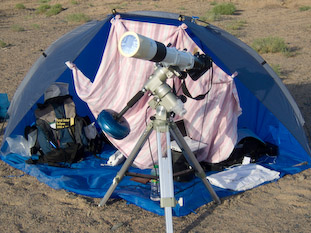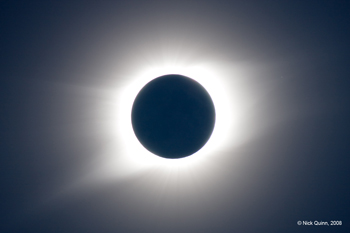Automatic Eclipse Photography
This brief article describes the camera system which I used to
automatically photograph the Total Solar Eclipse of 2008 August 1
(from the Xinjiang
Uyghur Autonomous Region of China. This is the second version
of the system that started life on a Psion 3, controlling 35mm
film cameras, as documented here.
There are four hardware elements to the system:
There are several software elements:
- the 'Open Source' camera control program gPhoto2
- a controlling Perl
script
- a C++ program 'eclipse' to calculate local circumstances
- SQLite database
management system
Asus Eee PC
The Eee PC runs the Linux Xandros operating system.
gPhoto2 and the Perl script run on the machine
controlling the 40D camera via both a USB and serial port
connection. The Perl script reads a series of commands
from a 'data' file and translates them into instructions
which are sent to the camera. Example commands in the
data file include 'set shutter speed' and 'fire shutter'.
Commands may be either executed immediately, or at a set
time and are stored in the SQLite database. For those
interested, the Perl script is available here.
To arrive at precise times of 2nd and 3rd contact, the
program I wrote for the Psion to calculate 'local
circumstances', based on the algorithms in Jean Meeus'
book 'Elements of Solar Eclipses 1951 - 2200', was
translated into C++ and compiled for the Eee PC. Limb
profile corrections were estimated graphically from the
diagram in the NASA
Solar Eclipse bulletins.
|
 |
Canon 40D DSLR camera
The Canon 40D camera contains a 10 megapixel APS-sized CMOS
sensor. It has 'LiveView' which proved invaluable in achieving
precise focus. The Eee PC had connections to both the USB and
remote switch sockets.
The 2008 August 1 Total Solar Eclipse
For the eclipse I used the 40D attached to a Borg 101ED
refractor with a 0.85x field-flattener mounted on a Vixen
Super-Polaris equatorial head. Prior to 1st contact the internal
clock on the Eee PC was set to UTC from the Garmin GPS 12XL via
the serial interface. The coordinates for the observation site
were also read from the 12XL and entered into the SQLite database
for use by the program that calculated the local circumstances.
The camera was fired for three sequences during totality: the
first run was from just before 2nd contact to capture Baily's
Beads, to 15 seconds after, for recording the chromosphere and
prominences. Exposure times ranged from 1/1000 - 1/60 second.
During the middle part of the eclipse a sequence of exposures
lasting from 1/250 - 4 seconds was taken to capture the inner,
middle and outer corona. The third sequence was around 3rd
contact to once again capture prominences, the chromosphere and
the diamond ring.
Pictures may be found here.
References
Glenn Schneider has an extensive article about his system
based on a Macintosh, at http://nicmosis.as.arizona.edu:8000/ECLIPSE_WEB/UMBRAPHILE/UMBRAPHILE.html,
and for Windows users Fred Bruenjes' Orchestrator
software was used to control many cameras along the 2008 eclipse
track.
Please get in touch if you have any questions or suggestions.

2008 November 11


